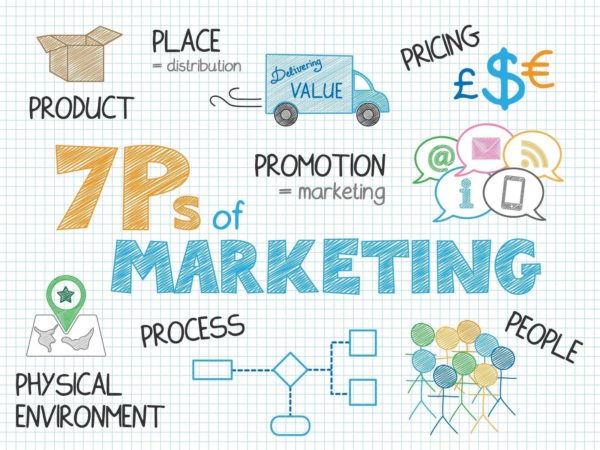
Marketing your products or services used to be simpler in many ways — you sold by word of mouth, from door to door, or through a catalog. But because of that, reach was limited. Today, while there are more businesses to compete with and more noise for consumers to sort through, there are also many more ways to reach customers and secure a sale.
Even back in the early 1950s, marketing specialists knew that growth would lead to a need for more refined strategies and a guide of some sort to help businesses ensure they were able to go beyond just their idea and begin making actual sales. Luckily for those responsible for marketing today, that knowledge became something that is now widely used for planning, evaluating, and revising the activities of businesses around the world.
Many companies use seven principles, called the 7 Ps of marketing, and a mix of different marketing tactics to help promote their products, services, and businesses — and you can too.
The 7 Ps along with a marketing mix help strategically place you in front of your customers and allow for a more targeted approach. Your marketing strategy is your signature, unique to you and recognizable by your customers, and much like every person has similar traits but looks different, how you use the 7 Ps will look different from other companies.
Below, you’ll learn why you should approach your business with a marketing mix mindset and how you can use the 7 Ps to guide you as you market your business.
What is a marketing mix?
Marketing mix refers to everything a business does to reach the goal of connecting their product or service to the people who need it, from first exposure to completion of the sale and beyond. It is the mix of strategies you draw on to support your sales cycle, and it will vary from company to company.
What makes a good marketing mix?
A good marketing mix will constantly evolve, changing as the needs of the consumer change. A good marketing mix can:
- Differentiate you from your competitors
- Allow you to be flexible
- Help you identify your priorities
- Reach new audiences
- Increase collaboration within your company
- Help you engage customers
- Help you build your brand identity
- Allow you to try out new strategies
- Inform you of what’s working and what isn’t
When to use your marketing mix
There are different theories about when to utilize your marketing mix, but there is no right or wrong way. Some companies choose to draw on their marketing mix before launching their business as a framework for planning their marketing objectives.
Others use it in their day-to-day marketing decisions so that they can attract the right audience and successfully market to them. Then some companies dip into their marketing mix to continually evaluate and reevaluate their business plan so that they can keep up with the ever-changing market and achieve maximum results.
No matter when you use your marketing mix, it’s always good to continually reflect on your strategies to change and adjust things based on your findings. For example, nearly every company had to take this approach during the COVID-19 pandemic to find creative ways to keep their businesses going.
What are the 7 Ps of marketing?

Remember those marketing specialists who had the forethought to know that some sort of guide would be helpful as marketing needs grew? They came up with the 7 Ps:
- Product
- Price
- Promotion
- Place
- People
- Physical evidence
- Processes
Of course, like any guide, there’s a history behind it. A speech by marketing specialist Neil Borden in the 1950s was the first time the term “marketing mix” was used. Later, marketing professor E. Jerome McCarthy refined Borden’s ideas, creating the 4 Ps of marketing (price, product, place, and promotion). He theorized that by using price, product, place, and promotion together, a business could identify its core customer and how to reach them best. He wrote about this in his 1960 book, Basic Marketing: A Managerial Approach.
Later, in 1981, as the art of marketing grew even more and customer service became even more important, Bernard H. Booms and Mary J. Bitner added three more Ps: people, physical evidence, and processes. Thus, the 7 Ps of marketing were born.
Today, companies use the 7 Ps of marketing to define and evaluate their marketing plan to reach their goals. To effectively use the 7 Ps, you should determine how each P affects the others to create a comprehensive approach.
Product
Your product (or service) is the core of your business. It’s what the customer ultimately cares about the most, so you should prioritize making it consumer-ready and as good as it can be. Your product is more than just the actual item, though. It’s the design, quality, features, options, packaging, and more. It’s what ignites your customer’s five senses and creates a desire to purchase in the first place.
A good product or service could almost sell itself. When you create a quality product, some consumers will see that value up front, while others will learn it for themselves after trying it.
Ultimately, you know your customer’s needs and should use that knowledge to help guide how you showcase your product’s value. Content marketing can help you do this: when you create informative content that helps build trust in you and your brand, consumers are more likely to buy from you.
To evaluate your product, you should think like an outsider. Ask yourself if it’s the right offering for the market today; is it what your customers need right now? You could also evaluate if it is comparable to a competitor, and if not, how you could make it better.
Price
How you determine your pricing depends on several factors, such as how it is priced in the market, how crowded the market is, if you have a unique selling position or special features you could draw attention to, if you’ll offer discounts or promotions, and future plans for coordinating products or services that could affect the price.
Once you set your price, you’ll need to reevaluate it periodically to see if it’s still appropriate for the current market. Prices can go up or down accordingly. You may need to change your pricing, terms of your sale, include free items, or bundle things together to give new life to a product.
Promotion
Promotion is how your product will get noticed. It includes everything you do to tell your customer about your business, from TV to radio to print, content marketing, discounts and sales, social media, email marketing, ads, search engine optimization (SEO), public relations, and more. Ideally, these promotion methods will easily flow together or build upon each other to help your target audience notice you.
For example, a customer sees an ad > they use their phone to read reviews and get pricing > they check out your website for any sales and to learn more > they make a purchase > that triggers your email marketing automation to send them a thank you and coupon for next time.
To utilize this marketing strategy best, you should make sure to identify all areas where you can impact the customer. Personalize your marketing at this time, using segmentation and automation tools, and test different approaches to see what customers respond to best.
Place
You’ll also need to know where you are going to sell your product or service. It is more than just your physical location. Your initial research should have helped with this, but it can always be modified, such as changing or adding a social platform to your marketing.
Ways (places) that businesses sell include trade shows, retail shops, websites, telemarketing, catalogs, direct selling, and more. Things that factor into this decision include whether your product or service needs to be seen in person or tested out, or whether an ecommerce site would work better. You might also consider how much customer interaction you want to have.
People
Anyone involved in your product or service or who comes into contact with your customer falls into the “people” category. This includes your employees, business partners, operations personnel, and anyone else your customer can associate with your company.
Businesses often forget this important aspect of marketing, but these people are the face of your company and reflect your product or service. You want to ensure they are well trained, understand the brand, and believe in your goals. When you hire someone, you also want to ensure they are professional and can get the job done right.
Jim Collins, author of Good to Great, explained it as the need to first “get the right people on the bus” and then “get them in the right seats.”
Physical evidence
With every purchase comes some proof. This is your physical evidence. It’s the completed haircut, a digital clipart PDF, the newest shade of lipstick, or the information learned during a webinar.
It’s also the thank you notes, receipts, confirmation emails, and other touches that go along with a sale that have your company’s information on them. These things make an impression as well, and all components should work together to benefit your brand’s look and feel.
With this P, you’ll want to make sure that all aspects of your product or service from beginning to end offer a consistent, enjoyable experience that keeps you in the customer’s mind.
Processes
The “process” aspect involves how your business runs. It’s how the service is delivered or how the product is packaged, and is part of what the customer pays for. Look at your logistics, shipment and delivery, supply chain, staff, checkout process, wait times, etc. The signature blue boxes from Tiffany’s or the separate Twitter account that Nike holds specifically for support (@NikeSupport) are a few examples.
The more seamless your processes are (which often relies on the “people” aspect of the 7 Ps), the happier your customer will be because no time will have been wasted while serving them. And keep an eye on complaints. If customers complain, it’s time to look into that process and reevaluate it.
Companies that use the 7 Ps the best
To see the 7 Ps of marketing in action, just look at how other companies utilize a few key areas of the marketing mix. While each company below considers all 7 Ps in their marketing efforts, they stand out because they have their marketing mix down to a science and excel at the specific 7 Ps identified in the examples.
Adidas
Adidas uses product, place, price, and promotion well in their marketing. They have a rather large product mix without overextending themselves. They offer sports attire for all, but also specialize in men’s, kid’s, and women’s items. They’ve included handbags and accessories in the mix too.
Their products are stylish and comfortable and speak to those of a sporty nature. They are placed around the world, running out of 55 countries, 800 factories, and more than 2,800 stores, including concept and outlet stores.
Because they have different brand names they operate under, they can market to different audiences at various price points. They often price items higher to make their perceived value increase and then draw customers in with sales.
They use technology to their advantage for promotion and make a user’s shopping experience highly convenient. They are active on social media with millions of followers and have a YouTube channel as well.
Netflix
Netflix is a well-known streaming service that has over 167 million subscribers taking advantage of their product. They focus on the customer experience and offer a wide range of original content that can’t be found anywhere else.
Netflix understands the importance of catering to its international audience and providing content in several languages and genres in each place they offer their service. They know that the primary user is a millennial but also offer content for kids and other consumers. And they price things according to the level of service, which caters to user preference.
Netflix’s process allows people to stream on any device, download content, create individual accounts, and have parental controls. And one of the favorite aspects is how they handle promotion — they recommend and rate shows based on user preference, which helps increase the time customers spend using their service.
Costco
Costco is a membership-only supermarket that has been open since 1983. Their promotion strategies include exclusiveness, which draws customers in; the bulk sales, ongoing deals, and unique Costco-only products help keep them there. There are also perks to being a member, like discounts on gas and points for cashback.
They have now placed themselves across the U.S. with over 800 warehouses that offer national and private label products at low prices and operate an ecommerce site with member perks. They pride themselves on being able to provide lower prices and exclusivity.
They’re also known for their people. They have an excellent company culture and best-in-class customer service. These aspects help make up their processes, and because things flow so smoothly, they often do not have to spend much on advertising.
Are you ready to evolve your marketing with the 7 Ps?
As you can see, the 7 Ps (product, price, promotion, place, people, physical evidence, and processes) create a guide to marketing that allows you to better reach your customers and make sales. The 7 Ps are a marketing mix of proven strategies that work for small or large companies alike. For a broader marketing overview learn more about how to market your small business.
Even if you don’t start off using all of them, moving toward use of the entire marketing mix will help your company meet its goals of effectively marketing to customers while increasing sales.
Constant Contact is the trusted solution for your online marketing needs. Covering many of the 7 Ps of marketing, we are accessible, insightful, efficient, and useful. From helping you launch an email marketing campaign to engaging customers to boosting sales, we have all the tools you need to take your business to the next level, all in one place. Reach out to us today to learn how we can help you with your marketing needs, or read our handy online marketing guide, The Download.




